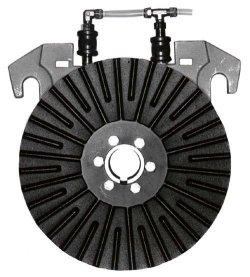
|
Brakes |
Tension Air Brake Easily Integrates for Smooth Unwind Upgrade
CAC’s newest Tension Air Brake (TAB) is engineered to be reliable, versatile and exceptionally easy to use. It is specifically designed to be easily employed with CAC’s widely used ShaftLok™ safety shaft holders for a complete unwind upgrade, but may also be integrated with less advanced, traditional shaft holders.
The TAB offers a broad torque range, excellent heat dissipation and operates on plain air. It can be operated manually via a simple pressure regulator or readily combined with an automatic tension control system. TAB has three friction coefficients to choose from and is available in 2, 4, 6 or 8 friction pad engagement configurations for a proper, custom torque match to individual setups.
Jeff Damour, CAC Engineering Manager, says the TAB is distinguished by an elegantly simple design that makes it especially easy to implement and operate.
“We apply everything we’ve learned over three decades to every web enhancement product we offer. All components, even the most basic, are carefully engineered and meticulously fabricated to fit smoothly into our building block approach to web handling,” Damour said.
Get the Most from Your Pneumatic Brake

If you unwind webs into a converting process, you may utilize pneumatically operated tension brakes to provide torque to the unwind shaft, which, in turn, supplies web tension feeding into your converting process. There are many controllable factors which can ensure your success using a pneumatic brake to control web tension in the unwind section of your process.
- Start by choosing the right type of pneumatic brake. Pneumatic brakes are used in many industries. Most are not designed for the specific challenges (keep reading) faced in web converting applications. Choose a pneumatic brake, specifically designed for web converting to avoid pitfalls associated with poor web tension control and brake heat dissipation.

Pneumatic Brake for Converting Applications
- Choose the right supplier. There are several suppliers of pneumatic brakes for web converting. Choose the right supplier for your requirements. Pricing, design, support and brake capabilities all come into play.
- Next, properly size the brake. Most pneumatic brakes are available in differing sizes. If you are unwinding a 10" wide paper, feeding into a process at 50 feet per minute the brake will be a different size from an application unwinding 80" wide film at 2,500 feet per minute. There are two factors to properly sizing an unwind brake; heat dissipation requirement and torque requirement (minimum to maximum). Each factor is separate, and each requirement must be properly met.

Example of Torque Range of Specific Brake Models
- Horsepower (heat dissipation) requirement. This is a measurement of how much heat your brake will generate in your application. The brake you select must dissipate your maximum horsepower generation. To calculate horsepower for your application, first multiply your maximum total web tension in pounds times your maximum web speed in feet per minute. Then divide that number by 33,000. So, HP = (tension (pounds) X speed (FPM)) / 33000.

Example of Heat Dissipation Rates
- Maximum torque requirement. This is the measurement of how much power your brake must bring to your unwind application in order to unwind your web at the tension level you require. To calculate your maximum torque (in pound inches) requirement, multiply your maximum roll diameter in inches times your maximum total web tension in pounds. Then divide that number by two. So, Tq (pound inches) = (diameter (inches) X tension (pounds) / 2.
- Visit: https://www.converteraccessory.com/ss/index.php to help with calculations
- Minimum torque requirement. This is the lowest amount of torque your application requires. This is a very important consideration because brakes have a minimum torque they can supply, and nothing controls to zero torque. To calculate minimum torque (in pound inches) requirement, multiply your core outside diameter in inches times your minimum total tension (considering your minimum web width) in pounds. Then divide that number by two. So, minimum Tq (pound inches) = (core O.D. (inches) X minimum tension (pounds)) / 2.
- Visit: https://www.converteraccessory.com/ss/index.php to help with calculations
- Once you know your horsepower requirement and your minimum to maximum torque requirement, selecting a brake becomes a process where you compare your requirements to horsepower and torque graphs of available brake models and sizes. Make sure your operating range for minimum to maximum torque and maximum horsepower requirements fall within the torque range and horsepower range of the desired brake. As you can see, in order to calculate the size of any brake you MUST KNOW YOUR TENSION. Statements like "Light", "heavy" or "whatever we need to stop the roll from freewheeling" do not help when calculating brake size. A number (in pounds) must be plugged into the equations described above. A guess at that number is still just a guess and whether the brake is properly specified and sized will be a guess as well. That been said, tension is often the hardest number to understand and know for your process because it is a transient force that is not readily measurable without a load-cell display. To understand more about tension and ways to measure tension, you may want to visit http://converteraccessory.com/papers and click on "The Mechanics of Tension Control White Paper".
- Select a pneumatic brake that is easy to maintain. Brakes used in converting slip continuously. This is sort of like driving your car while pressing on the brake and gas for the whole trip. Pneumatic brakes used in converting applications will require maintenance, which usually is in the form of replacing friction elements (pads). Choose a brake designed for easy maintenance.
Easy Brake Pad Change
View our video on YouTube- Choose the right control. Like the adage that a chain is only as strong as it's weakest link, a brake is only as good its control. Pneumatic pressure is adjusted to change the torque output of any pneumatic brake. There are three options for controlling the pneumatic pressure supplying the brake. Keep in mind, there are volumes written and whole training sessions devoted to differing tension control technology. These are just brief descriptions:
- Manual torque control. This is simply a pressure regulator which will change the pressure to the brake, changing the torque output. This is the least expensive option but also the least desirable. In all unwind applications, torque must decrease with roll diameter to maintain constant tension into the converting process. This is impossible with manual torque control, so as roll diameter decreases, tension will increase in the unwind tension zone of your process.

Example of Manual Control
- Open loop automatic tension control. Most of the time, this control incorporates an ultrasound sensor to measure roll radius and proportionally decrease pneumatic pressure going to the brake. This is much better than the previously mentioned manual torque control and is a perfect upgrade to that type of control. Ultrasound automatic tension controls are moderately priced and easy to install.

Example of Ultrasound, Open Loop Control
- Closed loop automatic tension controls like dancer roller assemblies or load cells control air pressure to the brake by measuring tension in the web. They adjust air pressure going to the brake to maintain a set point for tension set by the machine operator.

- Visit www.converteraccessory.com/papers and click on "The Mechanics of Tension Control White Paper". For MUCH more information on differing tension control options.
One thing is for sure; a properly specified pneumatic brake can help your converting operation by providing constant, controllable web tension in the unwind tension section of your process. This is the foundation, the starting point for converting your web perfectly.
CAC's Air Operated Web Tension Brake
View our video on YouTubeRETURN TO TOP |

 Please wait
Please wait




